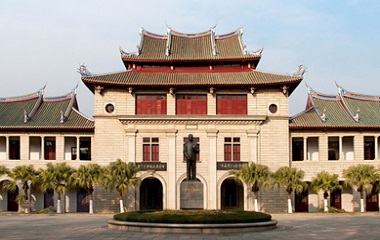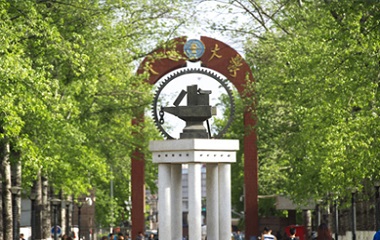
Jinan, with its blend of historical charm and modern opportunities, inspires young people worldwide.
In 1904, Jinan, the capital city of Shandong province in East China, received approval from the Qing Dynasty (1644-1911) government to open a commercial port. This decision positioned Jinan as the first major inland city in modern Chinese history to proactively engage with the outside world, marking a new chapter for this city.
Fast forward 120 years, a group of nine young individuals from the initial investing nations following the port's opening, including Germany, the UK, Japan, and the US, visited Jinan from June 21 to 23.
During their three-day stay, they explored the historical charm and contemporary vibrancy of Jinan, reflecting on the city's past while embracing the confidence and hope it instills in the present day.
Caspar William Zialor, a 32-year-old from the UK, is familiar with Jinan. Currently pursuing a master's degree in journalism and communication at Shanghai Jiao Tong University, he first began his long-term study in China at Qingdao University, also in Shandong.
Zialor noticed a significant similarity between Jinan and his hometown of London: both cities highlight their waterways, rivers, and canals as essential infrastructure for local economic growth.
He observed how Jinan has effectively used these advantages to engage in trade with international businesses. "This allows Jinan to grow from a traditional Chinese city into a more modern and dynamic one that creates the global opportunities it enjoys today," he said.
The long history of international exchange and cooperation has not only established a strong commercial foundation for Jinan but also cultivated an open mindset that embraces new products, technologies, and ideas. This openness continues to drive the city's economic development and industrial structure today.
As the Jinan industrial cluster features advanced green and low-carbon technologies, these young individuals have been exposed to the concept of local sustainable development, which integrates with cutting-edge industries like modern finance and the digital economy.
Antonia von Klot-Heydenfeldt, a 26-year-old mechanical engineering student from Germany currently pursuing a master's degree at Tsinghua University, found inspiration in Jinan's green industry. "I hope to work in this creative setting to learn from their advanced technologies and forward-thinking ideas," she said.
Leopold Martin Chen Lind, a 19-year-old from Germany, pointed out that Jinan's focus on low-carbon and zero-carbon development corresponds with international development trends. He noted that young people worldwide prioritize eco-friendly brands and are more likely to support environmentally conscious businesses. "This is why Jinan can attract young people from around the world; it aligns with what the younger generation values," he said.
Even 120 years later, Jinan's former commercial port district has not faded into history. Instead, it remains relevant and has evolved into a bustling modern business hub. Today, this area combines its storied past with contemporary vibrancy, offering a fusion of tradition and modernity.
Yuo Miri, a 19-year-old Japanese student at Shanghai Jiao Tong University, was captivated by the historic charm of the area. As an international student, she primarily relied on online resources for information about Jinan. While exploring Jinan travel guides, she noticed consistent mentions of the old commercial port. This district breathes new life into historic buildings with modern art, creating a vibrant space that appeals to young people worldwide.
"The blend of ancient and contemporary architecture and innovative business concepts here is truly remarkable," she said. "It's a fantastic spot for young individuals to chill out, enjoy afternoon tea or brunch, and immerse themselves in the city's laid-back atmosphere."
The establishment of the commercial port has also sparked cultural growth in Jinan.
For example, the city witnessed the emergence of its first natural history museum, theater, and professional cinema. These facilities, which have stood since the city's period of opening up, served as the cultural heart of that era, and they continue to stand as symbols of Jinan's commitment to preserving traditional culture and ancient architecture to this day.
During their travels, these young visitors explored the former site of the city's first cinema, the Xiaoguanghan Cinema Museum, established in 1904. They also had the opportunity to watch a segment from the classic Chinese film Dream of the Red Chamber.
Klot-Heydenfeldt was particularly fascinated by Xiaoguanghan's use of reels — a traditional technique — for screening movies.
Li Jianjun, the museum director, explained to her that Xiaoguanghan is the oldest surviving cinema in China and that the decision to use film reels aims to deepen people's understanding of the historical evolution of the Chinese movie industry.
"I think it's great how this place preserves tradition and helps people who come here to see the old machines and cameras," Klot-Heydenfeldt said. "It shows the development of these early devices to where we are now, which is great for people to understand how we came to this point in digitalization today."
Lind, familiar with the renowned literary work Dream of the Red Chamber, learned from Li that Xiaoguanghan cinema not only expands the horizons of Chinese audiences through film but also promotes outstanding Chinese works on a global scale.
Exploring the museum, Lind discovered that during the era of film reels, Xiaoguanghan stood out as one of the few cinemas in Jinan. Many viewers often requested the projectionist to replay the film after watching it because they were reluctant to leave.
"This realization highlights the profound human touch beneath technology," Lind said. "I believe that this is the most significant aspect of this journey — not just acquiring knowledge about Jinan from books or online sources, but actively connecting with the people here in person."










